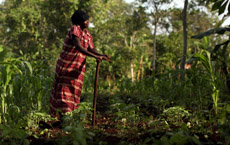New Analysis Compares African-American Hunger and Poverty with Circumstances in African Nations
Bread for the World released a new analysis today exploring connections between hunger and poverty in the African-American community to that in Africa. The analysis, titled “Shared History, Shared Experiences: Hunger and Poverty Among African-Americans and Africans ,” compares hunger and poverty in three African nations to that in U.S. states of similar sizes.

“Hunger and poverty among African-Americans mirror the unjust circumstances many people in African nations endure,” said Rev. Derrick Boykin, associate for African-American leadership outreach at Bread for the World. “However, hunger and poverty impacts many African nations more severely, often resulting in disease or even death.”
Though African-Americans make up only 13.6 percent of the U.S. population, they continue to suffer disproportionately from hunger and poverty. As of 2010—the most recent year for which data is available from the U.S. Census Bureau—nearly one-third of African-American households with children struggle to put food on the table. 2011 data will be released next month.
Similarly, one in three people in sub-Saharan Africa—a region about the size of the entire North American continent—suffers from chronic hunger. To emphasize the importance of African-American support for anti-hunger and anti-poverty initiatives in Africa, the analysis compares the states of Virginia, Texas, and Ohio to the African nations of Liberia, Tanzania, and Malawi.
Liberia is about the same size as Virginia, but its poverty rate is nearly quadruple that of African-Americans in that state. Similarly, three times as many Tanzanians live in poverty as do African-Americans in Texas. At 40 percent, the poverty rate in Malawi is slightly higher than the African-American poverty rate in Ohio (31 percent), but the degree of poverty is substantially greater in Malawi, where more than 40 percent of the population lives on less than $1 (U.S.) per day.
Less than one percent of the U.S. budget goes toward poverty-focused foreign assistance programs. However, these programs save more than 1 million lives annually, promoting sustainability and self-sufficiency.
“Our experiences may be similar but the degree of suffering in African nations is staggering,” added Rev. Boykin. “Cuts to anti-hunger and anti-poverty programs would have devastating impacts on vulnerable people in the United States and around the world. These programs save millions of lives by providing people with the necessary tools to help lift themselves out of poverty.”
Source: Bread for the World
- 286 reads
Human Rights
Ringing FOWPAL’s Peace Bell for the World:Nobel Peace Prize Laureates’ Visions and Actions

Protecting the World’s Cultural Diversity for a Sustainable Future

The Peace Bell Resonates at the 27th Eurasian Economic Summit

Declaration of World Day of the Power of Hope Endorsed by People in 158 Nations

Puppet Show I International Friendship Day 2020

